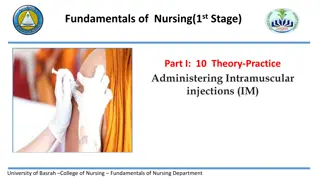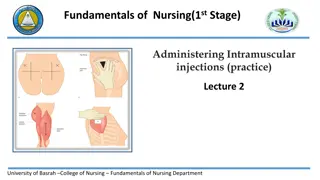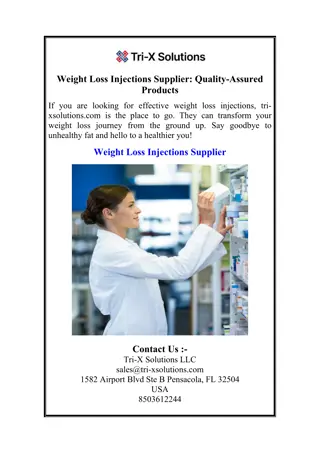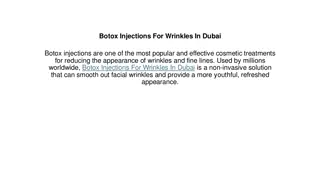Understanding Intravenous Infusions and Injections in Healthcare
Intravenous infusions and injections play crucial roles in healthcare by delivering drugs and fluids directly into the body. Injections can be administered in various ways, including intravenous, intramuscular, and subcutaneous routes. Intravenous infusions provide fluids, electrolytes, and medications directly into the bloodstream, helping to extend blood volume and deliver essential nutrients. Understanding the preparation of intravenous solutions and the equipment used for administration is essential for safe and effective healthcare practices.
Download Presentation

Please find below an Image/Link to download the presentation.
The content on the website is provided AS IS for your information and personal use only. It may not be sold, licensed, or shared on other websites without obtaining consent from the author. Download presentation by click this link. If you encounter any issues during the download, it is possible that the publisher has removed the file from their server.
E N D
Presentation Transcript
By Ali KhidherAlobaidy
Injections are sterile pharmaceutical solutions or suspensions of a drug substance in an aqueous or nonaqueous vehicle. They are administered by needle into almost any part of the body, including the joints (intra-articular), joint fluid (intrasynovial), spinal column (intraspinal), spinal fluid (intrathecal), arteries (intra-arterial), and in an emergency, even the heart (intracardiac). However, most injections are administered into a vein (intravenous, I.V), muscle (intramuscular, I.M), skin (intradermal, I.D, intracutaneous), or under the skin (subcutaneous).
Intravenous (IV) infusions are sterile, aqueous preparations administered intravenously in relatively large volumes. They are used to extend blood volume and/or provide electrolytes, nutrients, or medications. Most intravenous infusions are solutions; however, some are very fine dispersions of nutrients or therapeutic agents, or blood and blood products. Although some intravenous solutions are isotonic or nearly isotonic with blood, isotonicity is not absolutely necessary because the volumes of fluid usually administered are rapidly diluted by the circulating blood.
An administration set is attached to an intravenous bottle or bag to deliver the fluid into a patient s vein. The sets may be standard (macrodrip) or pediatric (microdrip). Depending on the particular set used, the drip rate can vary from 10 to 15 drops/mL for standard sets to 60 drops/mL for microdrip sets. The drip rate for blood transfusion sets is usually 10 to 15 drops/ mL with infusions of 250 to 500 mL administered over a 2- to 4-hour period. The passage of an infusion solution into a patient s vein of entry may be assisted by gravity (the solution is hung on a stand well above the portal of entry) or by electronic volumetric infusion pumps.
Intravenous infusions may be continuous or intermittent. In continuous infusions, large volumes of fluid (i.e., 250 to 1000 mL), with or without added drug, are run into a vein uninterrupted, whereas intermittent infusions are administered during scheduled periods.2 The rapid infusion of a medication into a vein is termed IV push and is usually conducted in less than a minute. Aqueous solutions chloride, and lactated Ringer s solution are the most commonly used intravenous fluids. of dextrose, sodium
How many grams each of dextrose and sodium chloride are used to prepare a 250-mL bag of D51 2NS for intravenous infusion? 250 mL x0.05 (5% w/v) = 12.5 g dextrose, and 250 mL x0.0045 (0.45% w/v) = 1.125 g sodium chloride
Compare (a) the number of drops and (b) the length of time, in minutes, required to deliver 50-mL of intravenous solutions when using a microdrip set, at 60 drops/mL, and a standard administration set, at 15 drops/mL, if in each case one drop is to be administered per second. Microdrip set: (a) 60 drops/mL x 50 mL = 3000 drops (b) 3000 drops / 60 drops/minute = 50 minutes. Standard set: (a) 15 drops/mL x 50 mL = 750 drops (b) 750 drops 60 drops/minute 12.5 minutes
How many grams each of sodium chloride and dextrose are present in a 1000mL IV bag of 0.18% sodium chloride and 4% dextrose? 1000 x 0.0018 = 1.8 g NaCl 1000 x 0.04 = 40 g dextrose How many grams each of sodium chloride, potassium chloride, calcium chloride, and dextrose are contained in a 500- with Additives mL IV bag of D5LR? 5% dextrose, 0.86% NaCl, 0.03% Kcl, 0.033% CaCl2. 0.05 x 500 = 25g 0.086 x 500 = 4.3g 0.0003 x 500 = 0.15g 0.00033 x 500 = 0.165g
The rapid injection of intravenous medications, as in emergency or critical care situations, is termed IV push, IVP, IV Stat, or sometimes a bolus dose. For the most part, drugs administered by IV push are intended to quickly control heart rate, blood pressure, cardiac output, respiration, or other life-threatening conditions. Intravenous push medications frequently are administered in less than one minute. The safe administration of a drug by IV push depends on precise calculations of dose and rate of administration.
A physician orders enalaprilat (VASOTEC IV) 2 mg IVP for a hypertensive patient. A pharmacist delivers several 1-mL injections, each containing 1.25 mg of enalaprilat. How many milliliters of the injection should be administered? 1.25 mg 2 mg X = 1.6mL (1 mL from one syringe and 0.6 mL from another). 1 mL x
A physician orders midazolam hydrochloride (VERSED) 2 mg IV Stat. A pharmacist delivers a vial containing midazolam hydrochloride 5 mg/mL. How many milliliters should be administered? 5 mg 2 mg 1 mL x x = 0.4mL
General guidelines in the treatment of severe diabetic ketoacidosis include an initial bolus dose of 0.1 to 0.4 unit of insulin/kg IVP, followed by an insulin drip. Calculate the bolus dosage range for a 200-lb patient. 1kg = 2.2Ib 200 lb / 2.2 lb/kg = 90.9 kg 90.9 kg x 0.1 unit/kg = 9.09 units 90.9 kg x 0.4 unit/kg = 36.36 units bolus dosage range for a 200-lb patient = 9.09-36.36
The preparation of intravenous admixtures involves the addition of one or more drugs to large volume sterile fluids such as sodium chloride injection, dextrose injection, lactated Ringer s injection, and others. The additives are generally in the form of small-volume sterile solutions packaged in ampules or vials. In any properly administered intravenous admixture program, all basic fluids, additives , and calculations must be carefully checked against the medication orders.
A medication order for a patient weighing 154 lb. calls for 0.25 mg of amphotericin B per kilogram of body weight to be added to 500 mL of 5% dextrose injection. If the amphotericin B is to be obtained from a constituted injection that contains 50 mg/10 mL, how many milliliters should be added to the dextrose injection? 1 kg = 2.2 lb. 154 (lb.) / 2.2 (lb.) = 70 kg 0.25 mg x 70 = 17.5 mg Constituted solution contains 50 mg/10 mL 50 (mg) 10 (mL) 17.5 (mg) x x = 3.5 mL
A medication order for a child weighing 44 lb. calls for polymyxin B sulfate to be administered by the intravenous drip method in a dosage of 7500 units/kg of body weight in 500 mL of 5% dextrose injection. Using a vial containing 500,000 units of polymyxin B sulfate and sodium chloride injection as the solvent, explain how you would obtain the polymyxin B sulfate needed in preparing the infusion. 1 kg = 2.2 lb. 44 / 2.2 = 20 kg 7500 units x 20 = 150,000 units Step 1. Dissolve contents of vial (500,000 units) in 10 mL of sodium chloride injection. Step 2. Add 3 mL of constituted solution to 500 mL of 5% dextrose injection. 500000 units 10ml x 1ml x = 50000
On medication orders, the physician specifies the rate of flow of intravenous fluids in milliliters per minute, drops per minute, amount of drug (as milligrams per hour), or, more frequently, as the approximate duration of time of administration of the total volume of the infusion. Pharmacists may be called on to perform or check rate-of-flow calculations using the following equation : Rate of flow (drops/minute) = {Volume infusion (mL) x Drip set (drops/mL)} / Time (minutes)
A medication order calls for 1000 mL of D5W to be administered over an 8-hour period. Using an IV administration set that delivers 10 drops/mL, how many drops per minute should be delivered to the patient? Volume of fluid = 1000 mL 8 hours = 480 minutes Rate of flow (drops/minute)= 1000 mL x 10 drops/mL /480 minutes = 20.8 or 21 drops per minute
Ten (10) milliliters of 10% calcium gluconate injection and 10 mL of multivitamin infusion are mixed with 500 mL of a 5% dextrose injection. The infusion is to be administered over 5 hours. If the dropper in the venoclysis set calibrates 15 drops/mL, at what rate, in drops per minute, should the flow be adjusted to administer the infusion over the desired time interval? Total volume of infusion =10 mL+ 10 mL+ 500 ml = 520 mL 5hrs. = 300 min. Rate of flow (drops/minute) = {520 mL x 15 drops/mL}/ 300 minutes = 26 drops per minute
An intravenous infusion contains 10 mL of a 1:5000 solution of isoproterenol hydrochloride and 500 mL of a 5% dextrose injection. At what flow rate should the infusion be administered to provide 5 g of isoproterenol hydrochloride per minute, and what time interval will be necessary for the administration of the entire infusion? 1 5000 X 10 x = 0.002g = 2mg 10 mL of a 1: 5000 solution contain 2 mg 2 mg or 2000 microgram are contained in a volume of 510 mL 2000 510 5 x X = 1.275 or 1.28 mL per minute 1.28 1 510 x x = 398 minutes or approx. 6.5 hours
If 10 mg of a drug are added to a 500-mL large-volume parenteral fluid: (a) what should be the rate of flow, in milliliters per hour, to deliver 1 mg of drug per hour? 10 500 1 x X = 50 mL per hour (b) If the infusion set delivers 15 drops/mL, what should be the rate of flow in drops per minute? 15 drops/mL x50 mL/hr = 750 drops per hour 750 (drops) 60 (minutes) x (drops) 1 (minute) X = 12.5 drops/minute (c) How many hours should the total infusion last? 50 (mL) 1 (hour) 500 (mL) x (hour) x =10 hours























